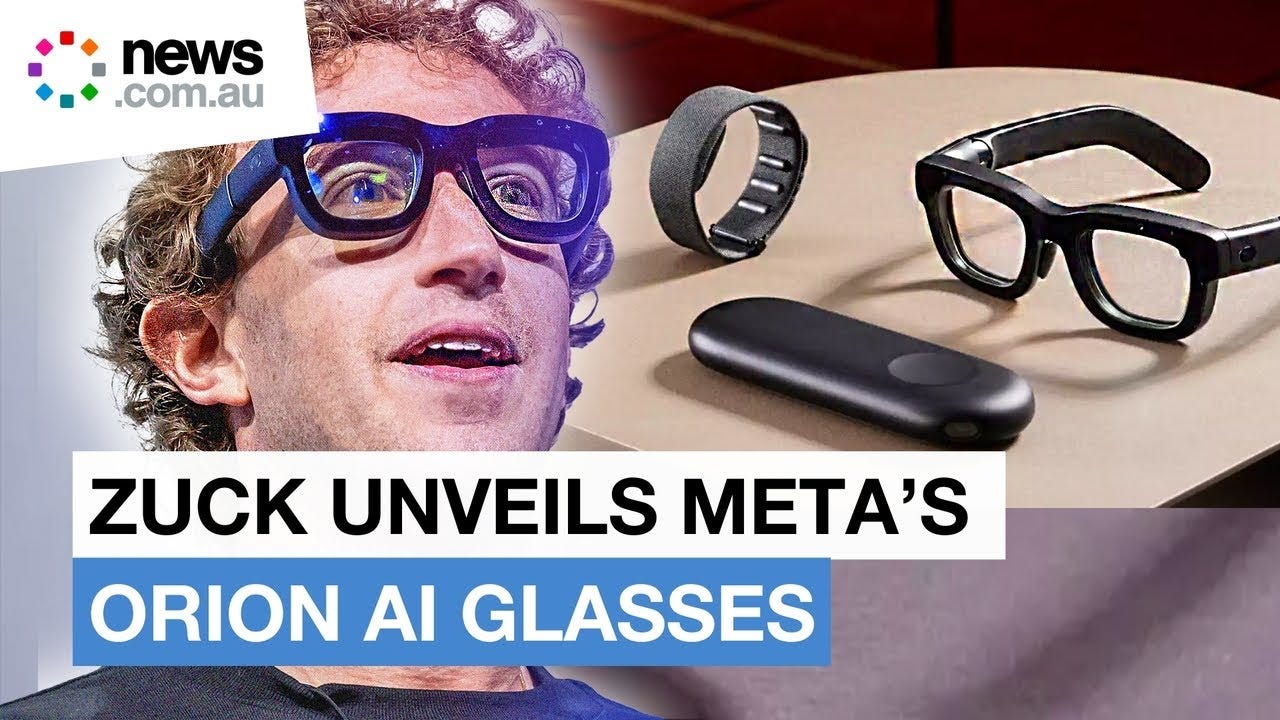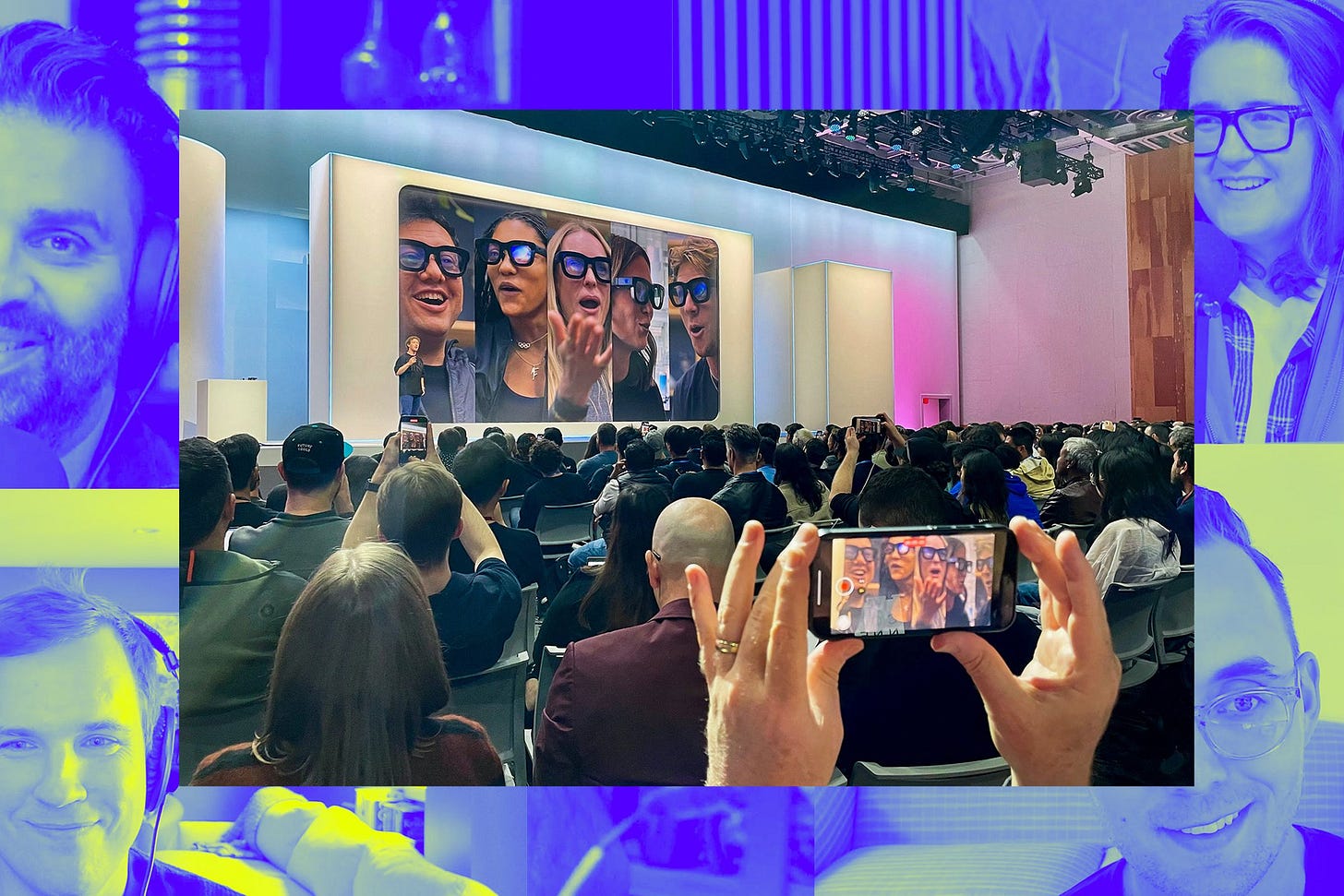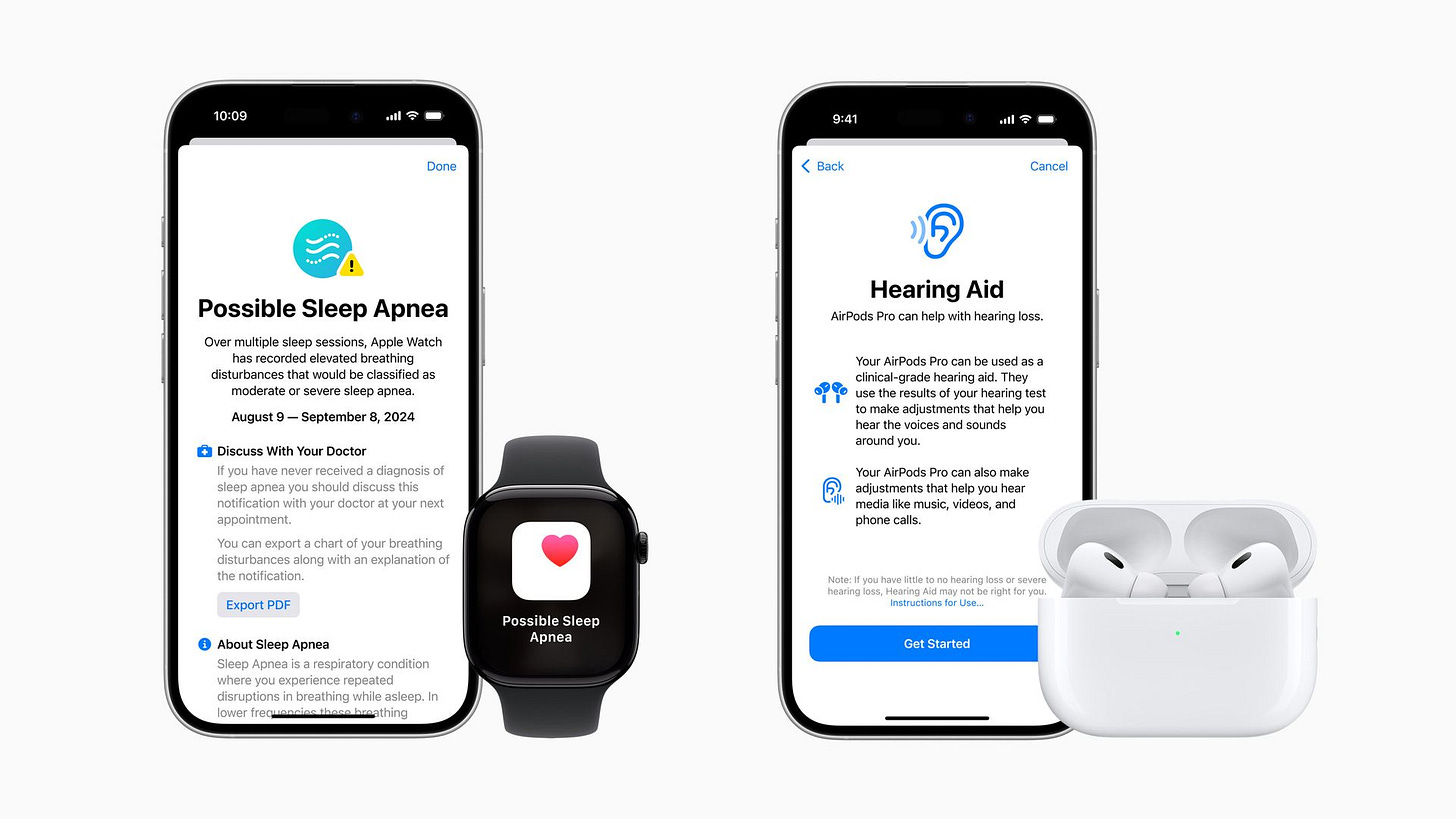AI: AI Wearable 'Science Projects' ahead. RTZ #496
...Meta, Apple, Snap, Google future plans for 'AI on our heads'
There’s a fashionable saying in Silicon Valley that the best entrepreneurs ‘pull in amazing innovations from the future’ to today. The ones spoken about reverentially in this ‘Tech Hero’ story of course are folks like Steve Jobs, Elon Musk, recently Sam Altman, and many others.
Iconic products along these lines are of course the iPhone, Tesla, Starlink broadband, and of course ChatGPT almost two years ago today. Most of the time, these innovations involve magical blends of software with hardware. Many times it’s just the software alone like the Visicalc, the first spreadsheet application for the PC in the early 1980s. And once released seem ‘inevitable in hindsight’.
What’s not quite understood in the mainstream is how long it took these individuals and their companies to actually do the work to pull in that ‘future’. Years of effort and expenditure into what were in effect ‘Science Projects’. Extraordinary amount of Research and Innovation needed. Huge amounts of collaboration amongst uniquely talented individuals, often with much turmoil and turnover. Much in the form of Basic Science before Applied Science could take over. Involving both amazing talent and amazing amounts of capital in the mix.
What brings this ‘hero story’ to mind of course is the buzz over the last few days over Meta founder/CEO Mark ‘Zuck’ Zuckerberg’s big reveal of their ‘Orion’ AR (artificial reality) glasses. The reactions have been generally positive, especially since Meta made the smart decision to not just demo them on stage at Meta’s Connect 2024 conference, but also have hundreds of industry and media ‘movers and shakers’ try on these glasses.
And almost universally these folks, some of them normally hard-nosed journalists, took a collective gasp of breath and gushed about having ‘seen the future’.
Never mind that these glasses are a ‘Science Project’, as emphasized from Zuck on down. Never mind that each of the 1,000 or so units commissioned by the company cost over $10,000 per unit in today’s dollars. (Makes Apple’s Vision Pros from a few months ago seem like a bargain at $3,400).
Never mind that this is not yet a product.
Never mind that the company says they won’t be available for mainstream purchase for a ‘few years’.
Never mind that the special ‘glass’ that makes these possible to be ‘pass-through’ without a projector screen on one’s face, is that the display is made of ‘Silicon Carbide’. Incredibly difficult to produce today. And it’s actually another way to describe a type of Industrial Diamonds. It’s estimated that 90% of the $10,000++ cost per unit is the cost of these main lenses. So to productize these, they have to find a close enough substitute. Another ‘Science Project’.
Also never mind that Zuck had the super majority control of Meta to spend what is estimated to be $50 billion or more towards this project, in the broader context of his ‘Metaverse’ ambitions. Even renamed the company in 2021 from Facebook to Meta in this quest. Now of course lauded as a brilliant success.
But last week was his victory curtain call. And he ‘stuck the landing’ with his keynote. Some even comparing it to Steve Jobs on a good day.
Regular readers know that I look at the world as a Tech Optimist, so these kinds of high risk, high reward investments are my ‘stock in trade’ for decades as a Tech analyst and investor. So I applaud Zuck and team’s accomplishments, despite the litany of ‘Never Minds’ above. I’m leaning into these next, next generation ‘Smart Glasses.
Indeed, I’m leaning into ‘AI on my head’, which is the long-term goal of these efforts, by these companies large and small. As I recounred a few days ago in ‘The enthusiasm for AI ‘Smart Glasses’:
“AI is going to be a blend of services driven by text, voice, cameras and video via a variety of devices over the next couple of years. Those are the ‘holy grail’ Box 6 in the AI Tech Stack chart below. And Meta, along with Apple, Google and others are in the race to put ‘AI on our Heads’.”
“AI ‘smart glasses’, which have been a ‘work in progress’ for over a decade. From Google Glass in 2012 to Meta’s partnership with EssilorLuxoticca’s Ray-ban on their Meta AI delivering ‘smart glasses today.”
But what’s important is how this all develops going forward in this AI Tech Wave:
“Right now it’s Meta and Apple that are competing to put ‘AI on our heads’ with glasses, ear buds, and other possible wearables. As I said above, Apple is also in the race with their ‘Vision Pro’ and Airpods Wearables. Indeed there are rumblings that Apple is testing cameras on their next iteration of Airpods over the next couple of years.”
And it’s important to understand WHY these companies are spending billions on these ‘Science Projects’:
“The prize for these companies of cameras on people’s heads is to serve customized AI responses to what people see around them. What Apple calls ‘Visual Intelligence’. Not to be confused with Apple Intelligence. Google is also very much in that part of the race, as are OpenAI and most of the major LLM AI companies.”
‘The secondary prize for all these companies, is that these cameras and microphones worn by billions of people allows them to capture the next mega-buckets of ‘Extractive Data’. With permission of course (most of the time). All needed urgently to power the next generation of LLM AI models.”
Imagine the data below going into the eyes and ears rather than the mouth.
“As I’ve said before, we’ve barely scratched the tip of the iceberg on Data for AI, real and synthetic. Big chunks of AI data to come is from the real world. Thus the cameras and devices around billions of users.”
“So that’s the bigger context around ‘AI Smart Glasses’, AR/VR and more. It’s about sensors around us, on our person and in our immediate surroundings. To both help interpret the world around us, and provide gushers of data for the next AI models.”
“As I’ve said before, technology always takes longer than we think, especially when it comes with blending software and hardware into delivering practical and affordable products and services at global scale. By companies large and small.”
Speaking of companies large and small, we’re referring also to Google and Snap, both with on and off ambitions for ‘AI on our heads’. And we have to of course discuss Apple, with its big efforts already around Apple’s Vision Pro, of which I remain a fan. And one I’ve discussed at length:
“We already saw the big push with ‘smart glasses’ on the high end with Apple’s Vision Pro. That is a multi-year exercise in product iteration until it finds it ‘product-market fit’.
Bloomberg today has a good list of Apple’s possible responses to Zuck’s big reveal of their ‘Orion’ Science Project, worth reading in full. In “Meta’s New Headsets Show Apple Has Lost Its Way With the Vision Pro”, Bloomberg’s Mark Gurman says:
“Meta’s latest AR glasses and cheaper mixed-reality headset add pressure on Apple to make its Vision push work.”
“Apple seems aware that it needs to rethink its approach to headsets, but there isn’t consensus on how to do that, I’m told. As of now, the company’s Vision Products Group is evaluating a few different options, including:”
1) “The status quo route: This would involve keeping the Vision Pro more or less the same but focusing on a less expensive version. Apple could bring down the cost with cheaper materials, lesser internal technologies and lower-quality displays. The company would also follow up with a second-generation version of the original, higher-end Vision Pro that has a new chip and Apple Intelligence.”
2) “The smart display route: In this scenario, Apple would remove the on-board computer and external battery from the Vision Pro and shift many of the internal functions over to the iPhone. This would make the iPhone more valuable, reduce the weight and heat of the headset, and — most importantly — eliminate several hundred dollars worth of components to bring down the price.”
3) “The smart glasses route: This would mean developing a product that’s closer to Meta’s hit collaboration with Ray-Ban — smart glasses without AR. Apple could use its expertise in chips and audio, as well as its growing collection of AI tools, to make a compelling device. This would essentially be a me-too product, but also something akin to an AirPods on steroids — and Apple fans would probably eat it up.”
4) “The AI and AirPods route: Apple is working on a new version of the AirPods Pro that uses external cameras and artificial intelligence to understand the outside world and provide information to the user. This would essentially be the smart glasses path — but without actual glasses.”
5) “The holy grail route: The ultimate goal is standalone augmented reality spectacles that come with high-performing lenses, a battery system, on-board computer, cameras, eye tracking and other components built-in— all while still being the size and weight of normal glasses. This has long been Chief Executive Officer Tim Cook’s dream, but Apple previously paused development of such a product because it was just too big a challenge.”
“Apple could ultimately release some or all of these products, but it’s going to need to accelerate its work — and fast. If not, Apple will risk losing out on a product category that could transform the way people use technology.”
The numbers on the quoted list are mine. It’s so that I can point to #4, the Airpods with a camera that seem to be Apple’s current ‘Science Project’. If they’re able to release it successfully in the next year or two, it would take SOME the wind out of the saild for both of Meta’s currently buzzy ‘AI on our head’ projects: The Ray-Ban Smart Glasses. It’s the one I’m most excited about in terms of having a camera on my face.
Partly because as I’ve said before, the feature I want most with an AI camera on my head is:
“As an aside, my most wanted feature via ‘smart glasses’ and/or Airpods with cameras, is the ability to identify people that I run into in real life. And provide information off the web in real time to have deeper, more engaging conversations with folks. Especially at networking events at conferences and parties. Lots of privacy issues there, but think the industry will figure out a way to scratch that burning need for billions.”
Mission Impossible style of course, amongst other SciFi imaginings.
Of course Apple’s already making headway on turning some ‘Science Projects’ into products, now even FDA approved Apple devices to help as hearing aids and for sleep apnea. AI wearable devices on our person, one even on our heads.
There’s another reason we live in an extraordinary time in this AI Tech Wave vs others. The number of concurrent ‘Science Projects’ that are going on, while ALMOST parallel efforts to productize said projects is relatively unprecedented.
I’ve already discussed at length the immense efforts at OpenAI to innovate on a long roadmap of AI ‘Smart Projects’ that are just software (for now). Their recent OpenAI o1 ‘Reasoning’ product (aka ‘Strawberry), is one case in point. It was years in the making. And Sam Altman has a lot more in the works. Not to mention his ‘Orion’ (aka GPT-5). A robust pipeline going forward.
Will have more on these and other software ‘Science Projects’ ‘pulling in the future’ in future posts.
For now, these other ‘Science Projects’, along with their concurrent productization, is what’s going to accelerate AI products and services from the future to here in this AI Tech Wave. There’ll be a lot that disappoint, but the ones that make us gasp with delight, and gush about to one and all. And in hindsight, will make it seem worth it. Stay tuned.
(NOTE: The discussions here are for information purposes only, and not meant as investment advice at any time. Thanks for joining us here)








